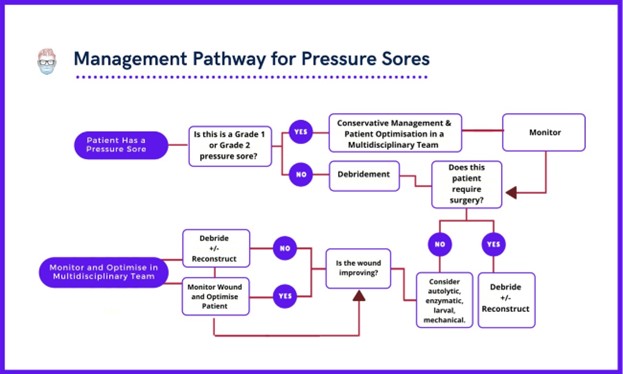A nurse is assessing a client who has a pressure ulcer. Which of the following findings should the nurse expect as an indication the wound is healing?
Wound tissue firm to palpation
Dry brown eschar
Light yellow exudate
Dark red granulation tissue
The Correct Answer is D
A pressure ulcer is a localized injury to the skin and underlying tissue caused by prolonged pressure, shear, friction, or moisture.
Granulation tissue is new connective tissue and blood vessels that form on the surface of a wound during healing . It is usually dark red or pink in color and moist in appearance . Wound tissue that is firm to palpation may indicate edema, inflammation, or infection . Dry brown eschar is dead tissue that covers the wound and prevents healing . Light yellow exudate is a sign of wound infection or necrosis .

Nursing Test Bank
Naxlex Comprehensive Predictor Exams
Related Questions
Correct Answer is A
Explanation
An acute asthma attack is a sudden worsening of asthma symptoms, such as coughing, wheezing, tightness in the chest, and difficulty breathing. These symptoms happen because the airways in the lungs become narrow, irritated, swollen, and produce excess mucus.
An asthma attack can be triggered by various factors, such as allergic reactions, respiratory infections, tobacco smoke, cold air, and exercise. These triggers cause the immune system to react and release chemicals that cause inflammation and constriction of the airways.
Based on this information, the best answer to the question is a. Inability to exhale retained carbon dioxide. This is because during an asthma attack, the narrowed airways make it harder to exhale the air from the lungs, which leads to a buildup of carbon dioxide in the blood. This can worsen the symptoms and cause acidosis, a condition where the blood becomes too acidic.
The other options are not correct because:
b. Acute loss of alveolar elasticity is not a cause of asthma attacks, but a consequence of chronic obstructive pulmonary disease (COPD), a different lung condition that involves damage to the alveoli, the tiny air sacs in the lungs.
c. Decreased responsiveness of airways to allergens is not a cause of asthma attacks, but a goal of asthma treatment. Asthma medications aim to reduce the sensitivity and inflammation of the airways to prevent or reduce the frequency and severity of asthma attacks.
d. Suppressed bronchiolar inflammatory response is not a cause of asthma attacks, but a potential side effect of some asthma medications, such as corticosteroids. These drugs can suppress the immune system and increase the risk of infections in the airways.
Correct Answer is B
Explanation
To assess a client for a positive Chvostek’s sign, the nurse should tap gently on the cheek, specifically two centimeters in front of the ear, over the facial nerve (also known as CN VII). This test is used to check for hypocalcemia, a condition that can lead to tetany, which is the involuntary contraction of muscles. A twitch of the facial muscles in response to this tapping indicates a positive Chvostek’s sign. This is particularly relevant following a thyroidectomy, as the procedure can indirectly affect the parathyroid glands, potentially leading to hypocalcemia
Whether you are a student looking to ace your exams or a practicing nurse seeking to enhance your expertise , our nursing education contents will empower you with the confidence and competence to make a difference in the lives of patients and become a respected leader in the healthcare field.
Visit Naxlex, invest in your future and unlock endless possibilities with our unparalleled nursing education contents today
Report Wrong Answer on the Current Question
Do you disagree with the answer? If yes, what is your expected answer? Explain.
Kindly be descriptive with the issue you are facing.

